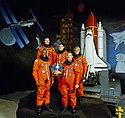STS-53
 | |
| Dane misji | |
| Indeks COSPAR | 1992-086A |
|---|---|
| Zaangażowani | |
| Oznaczenie kodowe | STS-53 |
| Pojazd | |
| Wahadłowiec | |
| Załoga | |
 Z przodu od lewej: Guion Bluford, James Voss. Z tyłu od lewej: David Walker, Robert Cabana, Michael Clifford | |
| Dowódca | |
| Start | |
| Miejsce startu | |
| Początek misji | 2 grudnia 1992 13:24:00 UTC |
| Orbita okołoziemska | |
| Apogeum | 322 km |
| Lądowanie | |
| Miejsce lądowania | Edwards AFB, Pas startowy 22 |
| Lądowanie | 9 grudnia 1992 20:43:47 UTC |
| Czas trwania misji | 7 dni, 7 godz, 19 min, 47 sek |
| Przebyta odległość | 4 883 843 km[1] |
| Liczba okrążeń Ziemi | 116[1] |
| Program lotów wahadłowców | |
STS-53 (ang. Space Transportation System) – piętnasta misja wahadłowca kosmicznego Discovery i pięćdziesiąta druga programu lotów wahadłowców[2].
Załoga
- źródło[2]
- David Walker (3)*, dowódca
- Robert Cabana (2), pilot
- Guion „Guy” Bluford (4), specjalista misji 1
- James Voss (2), specjalista misji 2
- Michael „Rick” Clifford (1), specjalista misji 3
- *(liczba w nawiasie oznacza liczbę lotów odbytych przez każdego z astronautów)
Parametry misji
- źródło[1]
- Masa:
- startowa orbitera: 110 654 kg
- lądującego orbitera: 87 639 kg
- ładunku: 11 868 kg
- Perygeum: 365 km
- Apogeum: 376 km
- Inklinacja: 57,0°
- Okres orbitalny: 92,0 min
Cel misji
Była to ostatnia misja wojskowa wahadłowca – głównym jej celem było umieszczenie na orbicie tajnego satelity USA-89. Był to satelita drugiej generacji wojskowego systemu telekomunikacyjnego Satellite Data System (SDS-2)[3]. Oprócz tego wahadłowiec zabrał dwa ładunki nieutajnione i dziewięć eksperymentów, również o charakterze jawnym[1].
Zobacz też
Przypisy
Linki zewnętrzne
- podsumowanie misji STS-53 na stronie KSC (ang.)
- Mark Wade: STS-53 (ang.). W: Encyclopedia Astronautica [on-line]. [dostęp 2017-07-25].
- Spaceflight mission report: STS-53 (ang.). Space Facts. [dostęp 2017-07-25].
Media użyte na tej stronie
The flag of Navassa Island is simply the United States flag. It does not have a "local" flag or "unofficial" flag; it is an uninhabited island. The version with a profile view was based on Flags of the World and as a fictional design has no status warranting a place on any Wiki. It was made up by a random person with no connection to the island, it has never flown on the island, and it has never received any sort of recognition or validation by any authority. The person quoted on that page has no authority to bestow a flag, "unofficial" or otherwise, on the island.
Emblem of Nasa's STS-53 mission
- Designed by the crewmembers, the STS-53 insignia shows the Space Shuttle Discovery rising to new achievements as it trails the symbol of the Astronaut Office against a backdrop of the American flag. The five stars and three stripes also serve to symbolize the mission designation (STS-53) and America's continuing commitment to world leadership in space. The pentagonal shape of the patch represents the Department of Defense (DOD) and its support of the Space Shuttle Program. The band delineating the flag from space includes the four colors of the military services of the crewmembers. The names of the flight crewmembers are located along the border of the patch. They are Commander David M. Walker, Pilot Robert D. Cabana, Mission Specialist (MS) Guion S. Bluford, MS James S. Voss, and MS Michael R. U. Clifford. Each crewmember contributed to the design of the insignia.
The STS-53 crew portrait included astronauts (front left to right): Guion S. Bluford, and James S. Voss, mission specialists. On the back row, left to right, are David M. Walker, commander; Robert D. Cabana, Pilot; and Michael R. (Rick) Clifford, mission specialist. The crew launched aboard the Space Shuttle Discovery on December 2, 1992 at 8:24:00 am (EST). This mission marked the final classified shuttle flight for the Department of Defense (DOD).


